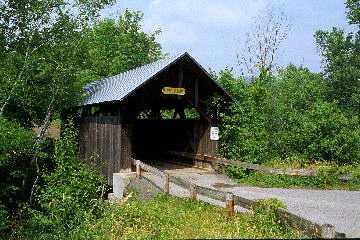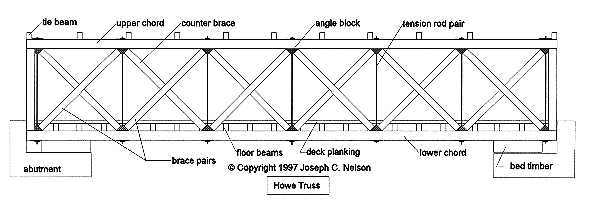goldbrk
The Gold Brook Bridge in Stowe
From Spanning Time Tour 9
Stowe has long been one of Vermont s leading tourist towns. As early as the middle 1800s, it was common for strangers with fine apparel, fine horses, and fine carriages to stay for three or four months of the year. The summer people gave the town the reputation as the Saratoga of Vermont.
Stowe has three villages. Center Village is located at the geographical middle of the town, where all roads meet. A half mile to the south lies Lower Village, once known as Mill Village. This is where the trades, such as the mills and blacksmith shops, were located. The third village is Moscow, two miles south of Center Village. Moscow was known to have one of the best sawmills in the state, as well as a large door, sash, and blind factory.

The dark little Gold Brook Bridge crosses Gold Brook at a busy joining of well-kept country roads. The impression of darkness comes from the walnut-stained gable-ends, but there is also a dark side to the bridge's history. For this is Emily's Bridge, haunted by a locally famous ghost.
Many stories have been told about why poor Emily does not rest in peace. Perhaps the most popular legend has it that in the middle 1800s, Emily, a farmer's daughter, was deserted by her lover. Despairing and, sadly, in a family way, she hanged herself in the bridge. Her ghost has been seen on moonlighted midsummer nights, wandering through the bridge waiting for her man.
The first span to cross Gold Brook at this site was constructed in 1803. John W. Smith designed and built the present bridge in 1844 using the Howe Truss. Finding a Howe truss in a forty-eight-foot highway bridge in the middle of Vermont is something of a surprise--the design was used for the much more stringent loading requirements of a railroad span. The truss has historical significance for its use of iron rods and angle blocks--it showed a growing industrial capacity. The only other surviving examples of the Howe truss in Vermont are the Connecticut River bridges at Lunenburg and Lemington, and the Rutland Railroad Bridge at Shoreham.
Emily's Bridge is in very good condition and is likely to remain so. In 1969 the town made a resolution for perpetual care. The declaration is displayed on a bronze plaque placed in a grassy area near the east portal.
To read more about Emily and the bridge, see Robert Hagerman's Covered Bridges of Lamoille County.
William Howe patented a wood and iron rod truss in 1840 and extended the patent with improvements in 1850. The truss was the first to be designed using mathematical stress analysis. The Howe truss, suitable for heavy duty bridge spans, was adopted by the railroad industry and became one of the most widely used trusses for railroad bridges.
The truss consists of wooden upper and lower chords, the chords linked together with sets of dual iron rods and wooden braces and counter braces. The braces and counter braces are butted against the chords on angle blocks. The rods are adjusted with nuts.

Of the four Howe truss bridges in Vermont, three are highway bridges. The Gold Brook Bridge in Stowe, built in 1844, is the oldest and is a miniature of the other three. The retired Rutland Rail Road Bridge in Shoreham is the last of Vermont's Howe truss railroad spans. The Connecticut River bridges in Lunenburg and Lemington, both Howe Truss highway bridges, are constructed with identical components, both having been built by the same company. The iron rods are one-and-three-quarter-inches in diameter, the braces measure seven by nine inches, and the counterbraces are six by six inches. The angle blocks are wood.
William Howe, born in 1803 in Spenser Massachusetts, came from a family of inventors. Tyler Howe invented a spring bed and Elias Howe was the inventor of the sewing machine.
For more on the Howe Truss and William Howe see Yankee Science in the Making, by Dirk J. Struik
Joe Nelson
P.O Box 267, Jericho, VT 05465-0267
jcnelson@together.net
No part of this web site may be reproduced for commercial purposes without written permission of Joseph C.
Nelson
Text Copyright © 1997, Joseph C. Nelson
Photographs Copyright ©, 1997, Joseph C. Nelson
Illustrations Copyright ©, 1997, Joseph C. Nelson
This file updated 12-4-99